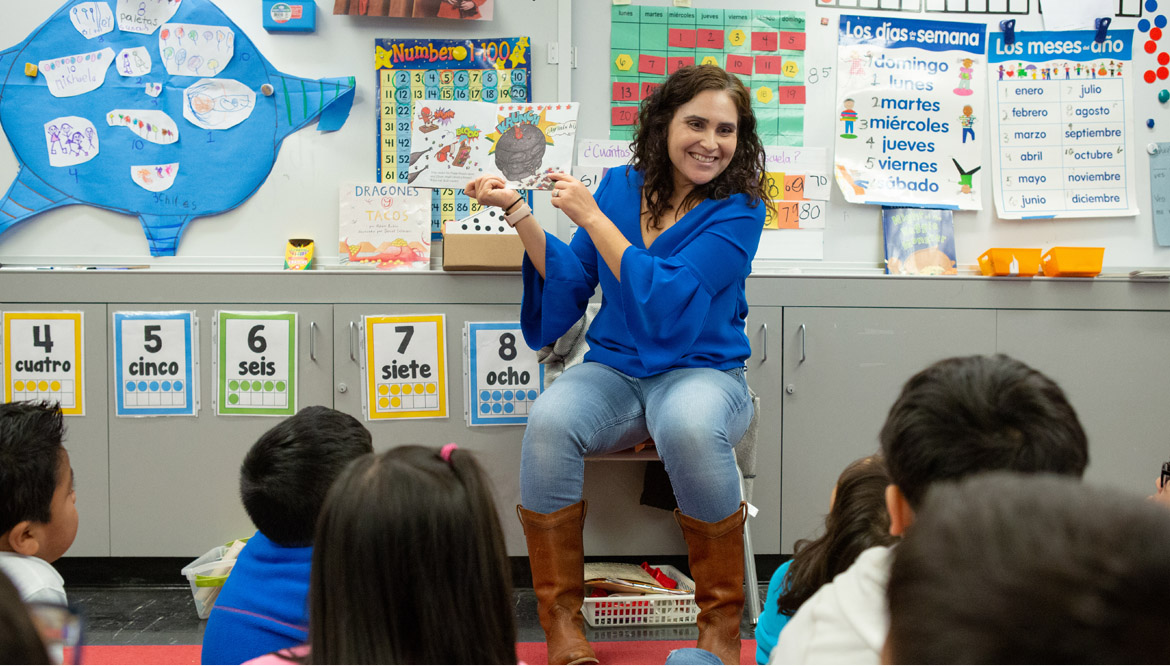11) How can I build my capacity to serve Multilingual Learners?
By exploring this website, you are on the path to building knowledge and skills for serving Multilingual Learners (MLs). As you do this, you will build more confidence that you can meet these children where they are and help build their skills. In addition to learning and exploring the strategies in the website, ongoing professional learning is critical for helping to ensure that you can implement them effectively. In fact, the Master Plan for Early Learning and Care, released in 2020, highlights workforce development and enhancing educator competencies for serving ML children as a key goal to improving education for all. This learning is best achieved through consistent, sustained, and local job-embedded professional development opportunities that are driven by data reflecting where children are and where they need to go.49
You can search across all strategies by keyword on our Research Search page. Give it a try!
Evidence-Based Strategies and Resources
11A) Building knowledge of dual language development through research
TK
More than 60 minutes
Document
Policy Brief: Teaching Academic Content and Literacy to English Learners in Elementary School
15-30 minutes
Document
Research Article: Teaching English Language Learners-What the Research Does–and Does Not– Say
TK
30-60 minutes
TK
15-30 minutes
TK
10-15 minutes
TK
30-60 minutes
30-60 minutes
TK
15-30 minutes
TK
15-30 minutes
TK
2 hours
TK
More than 60 mins
TK
More than 60 mins
TK
More than 60 minutes
11B) Supporting teacher collaboration and development
TK
Under 5 minutes
Downloadable template
Template: Self-Reflection Tool and Roles in Supporting Children’s Oral Language Development
TK
Under 5 minutes
TK
More than 60 minutes
TK
30-60 minutes
TK
10-15 minutes
5-10 minutes
11C) Administering programwide and community supports for multilingual learning
TK
30-60 minutes
TK
10-15 minutes
TK
10-15 minutes
TK
15-30 minutes
TK
30-60 minutes
TK
5-10 minutes
TK
10-15 minutes
30-60 minutes
TK
10-15 minutes
11D) Integrating new research on literacy/Science of Reading
10-15 minutes
5-10 minutes
TK
More than 60 minutes
TK
30-60 minutes
TK
5-10 minutes
TK
5-10 minutes
TK
10-15 minutes

Additional Professional Development programs
Here are some Professional Development (PD) programs and resources that you can check out to learn more about how to build you and your team’s capacity to serve MLs:
CA DLL PD Project at California State University Channel Islands
This site describes an innovative DLL professional development program for the California Early Childhood Workforce. The site describes the components of the PD program, as well as links to some helpful resources, including a book list and other recommended resources.
Age Level
Preschool
CABE’s Dual Language Teacher Academy (DLTA)
This 8-module program (2 English and 6 Spanish), will prepare DL educators with higher levels of academic Spanish and effective DL pedagogical knowledge and practices.
Age Level
P–12th grade
California Preschool Instructional Network (CPIN)
CPIN provides a number of professional topics and training sessions, including one dedicated to English Language Development (ELD). Check their menu of Professional Learning opportunities to learn more about what is covered in the ELD training.
Website
Age Level
Preschool & TK
Preschool & TK
Personalized Oral Language Learning Strategies, from the Language Learning Project (LLP)
The LLP project provides a free, online toolkit that explains how to implement Personalized Oral Language Learning (POLL) strategies (based on current dual language research) into the classroom, with video and picture examples of the strategies. It also provides brief foundational professional development training sessions.
Website
Age Level
Birth-5
Birth-5
Project GLAD® (Guided Language Acquisition Design) National Training Center
A professional development organization that provides training (grades P–12) in language acquisition and literacy. Trainings provide teachers with practical tools and strategies for how to implement the GLAD® model to promote academic language and literacy.
Website
Age Level
Preschool & Elementary
Preschool & Elementary
Sobrato Early Academic Language (SEAL)
A research-based program that provides professional development, curriculum support, and technical assistance to give educators and school systems the knowledge they need to provide high-quality education to all MLs.
Website
Age Level
Preschool & Elementary
Preschool & Elementary
Young Multilingual Learners Program at SRI Education
The Young Multilingual Learners Program at SRI Education focuses on enhancing educators’ mindset and skillset to effectively incorporate children’s home life experiences, cultural background, home languages, interests, and strengths. It provides professional development, advising, and technical assistance, and engages in research and evaluation for programs serving children from birth to age eight.
Age Level
Birth-8
Insights from the Field in Response to the COVID-19 Pandemic
During the COVID-19 pandemic, virtual and hybrid learning has increased. While there is little research on effective practices for virtual instruction for young MLs, there are some considerations and lessons learned from the field for adapting practices to a virtual environment, including:
- Focus on developing relationships with families and supporting the role of caregivers as partners in learning activities.
- Devise robust plans for communicating with and collaborating with families.
- Support parents with technology and virtual platforms.
- Help parents understand this is an optimal time for them to promote the use of the home language.
- Provide culturally responsive and trauma-informed support to families, recognizing the added stress the pandemic and virtual learning can have.
- Deliver online virtual learning at times convenient for families’ schedules and needs.
- Identify ML-specific strategies that are most relevant and appropriate for virtual delivery.
- Emphasize oral language development: make sure DLLs/ELs have opportunities to use language, particularly during synchronous learning periods.
- Provide small group and individual learning opportunities virtually.
- When planning, consider if an adult is required to be present for the learning activities provided.
- Deliver PD virtually to allow for flexibility and access for educators.

Strategies are interrelated
Individual strategies across the different instructional topics are interconnected and should be implemented together, in a purposeful and connected manner throughout instruction, and not in isolation. Make sure to also consider your classroom or school’s language model when implementing the strategies and adapt accordingly.
Visit how to use this site >



